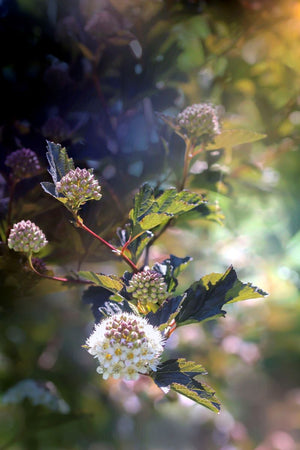Ninebark: Four-Season Structure and Bold Foliage
Welcome to this week’s edition of our "Plant of the Week" series. This week we’re featuring a shrub that does it all—Ninebark (Physocarpus opulifolius), a North American native known for its colorful foliage, peeling bark, and adaptability in tough landscape conditions. With selections in shades of burgundy, copper, lime, and nearly black, Ninebark adds structure and drama from spring through winter. It’s tough, low-maintenance, and ideal for modern, native, or wildlife-friendly gardens.


What Makes Ninebark Special?
Ninebark (Physocarpus opulifolius) stands out for its dramatic foliage, seasonal contrast, and textural interest. Its most distinctive feature is the exfoliating bark, which peels away in layers to reveal rich inner tones of cinnamon, copper, and reddish-brown—making the shrub compelling even in winter.
In spring and summer, Ninebark produces vibrant new leaves in colors ranging from deep burgundy to bronze, copper, or plum, depending on the cultivar. A variety like ‘Diabolo’ (or another dark-leaf selection you carry) displays intense maroon foliage that adds strong contrast to lighter-colored plantings. By late spring and early summer, flat clusters of white or pinkish flowers appear, attracting pollinators and softening the plant’s bold foliage. Later in the season, the display continues with reddish seed capsules and the peeling bark, providing multi-season interest.
Adapted to a wide range of soil conditions and climates, Ninebark is also prized for its toughness: it tolerates sun to part shade, thrives in clay and rocky soils, and is both deer-resistant and low maintenance. Its combination of texture, color change, and structural presence makes it a standout in any garden.

How to Use Ninebark in the Garden
Thanks to its color range and textural contrast, Ninebark fits a wide array of landscape styles.
Focal Point in Shrub Borders
With bold foliage and seasonal changes, Ninebark is a natural focal point in mixed borders. Use darker varieties like 'Summer Wine’ to anchor a perennial bed, or mix in golden-leaf types like ‘Ginger Wine’ to brighten up darker spaces.
Screening and Mass Planting
Taller cultivars work well as informal screens or mass plantings along property lines. Their density and height offer privacy while the colorful foliage provides visual interest far beyond basic hedges.
Foundation Plantings and Small Spaces
Compact selections like ‘Little Devil’ or ‘Tiny Wine’ are well-suited for foundation beds or small gardens, offering all the color and texture of larger types without the size. Their low-maintenance habit and tight form make them ideal substitutes for barberry in deer-prone areas.
Pollinator and Native Plant Gardens
Ninebark’s flowers attract bees and butterflies, while the seed heads and bark offer habitat and food for birds and insects. Its native status makes it a valuable addition to ecological landscapes, especially when paired with Echinacea, Asclepias, or Amsonia.
Winter Interest Plantings
In leafless months, Ninebark reveals its peeling bark, which adds color and texture to otherwise quiet gardens. Place it near evergreens or red-twig dogwood for contrast and layered winter displays.

How to Care for Ninebark
Ninebark is as tough as it is beautiful, thriving with minimal care in a wide range of environments.
Planting: Choose a location with full sun to part shade. More sun results in deeper foliage color. It tolerates a wide variety of soils, including clay and poor drainage.
Watering: Water regularly during the first season to establish roots. Once established, Ninebark is drought-tolerant and needs little supplemental watering.
Pruning: Ninebark blooms on old wood, so prune immediately after flowering if needed. Remove older canes at the base every few years to maintain shape and encourage new growth. Avoid cutting back in fall or early spring, which will reduce flowering.
Fertilizing: Typically not required. If needed, apply a balanced slow-release fertilizer in early spring.
Spacing: Allow 3 to 6 feet of spacing, depending on the variety’s mature size and desired use.
Pests & Disease: Ninebark is generally pest-free, but some varieties are prone to powdery mildew, especially in humid conditions. Improve air circulation by thinning growth or selecting mildew-resistant cultivars like ‘Summer Wine’.
CONCLUSION
The Ninebark is a remarkable and versatile shrub that brings beauty and resilience to any landscape. With its stunning peeling bark, vibrant fall foliage, and adaptability, the Ninebark adds a touch of elegance and charm. Whether used as a shade tree or as a focal point in a garden, its distinctive features enhance the aesthetic appeal of outdoor spaces. Furthermore, the Ninebark's ability to thrive in urban environments makes it an excellent choice for city gardens, where it withstands pollution and contributes to the overall beauty of urban landscapes. By ensuring well-drained soil, proper watering, and regular care, the Ninebark will flourish, providing year-round beauty and enhancing the natural splendor of your outdoor space.
Check out the entire 'Plant of the week' series
Shop Our Ninebark Collection
Sold Out
Sold Out
Sold Out
Sold Out
Sold Out






